BOLZANIO, Urbano
Grammaticae Institutiones ad Graeca lingua
Venice, Paolo Manuzio, 1557£1,950.00
8vo, ff. 322. Italic and Greek letter, some Roman. Printer’s woodcut device on title page and privilege on last verso. Light age yellowing, small marginal water stain to first couple of gatherings and larger from 306 till the end; occasionally spotted. A good, crisp copy in contemporary vellum over boards, remains of ties, early inked title to spine, yapp edges. Contemporary Latin notes on ff. 8-18, early owner’s signature – “Girolamo Benassai”, nobleman from Lucca (C1600) – on first p. verso and armorial bookplate of Sir George August Shuckburgh-Evelyn, 6th Baronet (1751 –1804) on front pastedown.
Later issue of the successful third extended edition of the important Greek grammar by the Franciscan friar Urbano delle Fosse, better known as Urbano Bolzanio (1442-1524). The work had three editions (1498, 1512, 1545) and several reprints in relatively a few years. It was the first Greek grammar written in Latin and contributed to the spreading of this ancient language in the Western world. The 1545 edition was composed in 1523 and later published thanks to Pierio Valeriano, Bolzanio’s nephew.
Pupil of the famous Constantine Lascaris from Constantinople, Bolzanio became one of the most celebrated humanists of his time. After leaving his home city he travelled in Greece, Palestine, Arabia, Egypt and Sicily, collecting inscriptions. In Messina he attended Costantino Lascaris’s lectures. In 1484 he moved to Florence at the invitation of Lorenzo de’ Medici who appointed him tutor to his son Giovanni, the future Pope Leo X. In 1490 he returned to Venice where he taught Greek and collaborated with Aldo Manuzio, who published the first edition of his grammar, dedicated to Giovanni Francesco Pico della Mirandola. Bolzanio also joined the Aldine academy, meeting Pietro Bembo and Erasmus, with whom he edited the Adagia (1508).
According to Antonio Rollo (“La grammativa greca di Urbanio Bolzanio”, 2001), Bolzanio’s work was very innovative and occupied an important place in the study of Greek grammar. It offers an extensive synthesis of theories and teachings drawn from the author’s knowledge of the Byzantine grammatical tradition, especially Manuel Chrysoloras, Constantine Lascaris and Theodor Gaza.
This edition includes nine books, divided into four groups: the first three are dedicated to the basics (alphabet, accent, article, declension of noun, pronoun and adjective, verb); the following four (4-7) include exceptions in the different dialects, syllable count, use of patronymics and diminutives, verb conjugation; the eighth and ninth concern the irregular verbs, especially those ending in – . There follows a list of the monosyllables and the meanings of in the Hellenistic grammarian Tryphon’s De passionibus dictionum (C1th BC). The text embraces examples from classical (Homer, Hesiod, the Greek tragedians, Thucydides, Demosthenes, various writers and poets) and contemporary authors and inscriptions.
Adams, B 2366; Ahmanson-Murphy, 516; BM STC It. p. 117; Renouard, 171: 6.In stock






